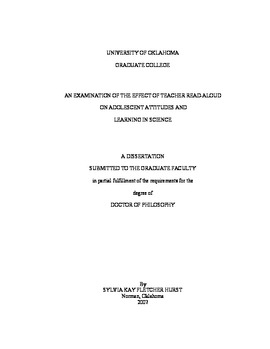| dc.contributor.advisor | Griffith, Priscilla L., | en_US |
| dc.contributor.author | Hurst, Sylvia Kay Fletcher. | en_US |
| dc.date.accessioned | 2013-08-16T12:20:42Z | |
| dc.date.available | 2013-08-16T12:20:42Z | |
| dc.date.issued | 2007 | en_US |
| dc.identifier.uri | https://hdl.handle.net/11244/1208 | |
| dc.description.abstract | A repeated measures analysis suggested both teacher read-aloud and silent reading were appropriate for student learning but results do not support either method as superior over the other. Multiple regression analyses were conducted on the posttest and delayed posttest scores as the dependent measured, had a significant relationship between treatment by reading ability interaction on one analysis. Regression equations constructed for each level of the treatment indicated that as reading ability increases, students received more benefits from the teacher read-aloud procedure. | en_US |
| dc.description.abstract | The study was a counterbalanced design gathering both quantitative and qualitative data for analysis from two treatment procedures. Seventh and eighth grade students were given the reading portion of the SAT-9 to provide a national percentile ranking in reading. All students then participated in two consecutive units of study: one unit requiring students to read the science text silently and the second unit providing a teacher read-aloud of all text. The classroom procedures, assignments, and related activities were exactly the same for both treatments. Student learning was measured with pretest, posttest, and delayed posttest concept map scores on each unit of study. | en_US |
| dc.description.abstract | A survey administered at the end of the study examined student attitudes toward the teacher read-aloud and served as the source for in-depth interviews concerning preference for or dislike of the teacher read-aloud strategy. An interview with the science teacher provided another outlook on the oral reading treatment. | en_US |
| dc.description.abstract | A correlation compared reading ability with attitude toward teacher read-aloud. Seventy-eight of the participants had a positive attitude toward the intervention, with no students reading below the 50th percentile showing disapproval. Interview responses supported these results since all below average readers favor the oral presentation. Overall themes from the interviews offered advantages and disadvantages of teacher read-aloud, suggestions for implementation, and a teacher's perspective on practical applications in science classes. | en_US |
| dc.description.abstract | Having been established as an important component of early literacy development, the use of teacher read-aloud as an instructional strategy has the potential to benefit adolescent students. The purpose of this study was to examine the effect teacher read-aloud had on adolescent learning in science and how the results varied according to individual reading ability. | en_US |
| dc.format.extent | xi, 124 leaves : | en_US |
| dc.subject | Lecture method in teaching. | en_US |
| dc.subject | Science Study and teaching (Middle school) | en_US |
| dc.subject | Education, Sciences. | en_US |
| dc.subject | Education, Reading. | en_US |
| dc.title | An examination of the effect of teacher read-aloud on adolescent attitudes and learning in science. | en_US |
| dc.type | Thesis | en_US |
| dc.thesis.degree | Ph.D. | en_US |
| dc.thesis.degreeDiscipline | Department of Instructional Leadership and Academic Curriculum | en_US |
| dc.note | Source: Dissertation Abstracts International, Volume: 68-04, Section: A, page: 1385. | en_US |
| dc.note | Adviser: Priscilla L. Griffith. | en_US |
| ou.identifier | (UMI)AAI3263435 | en_US |
| ou.group | Jeannine Rainbolt College of Education::Department of Instructional Leadership and Academic Curriculum | |
